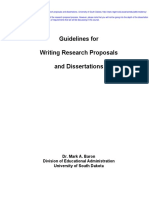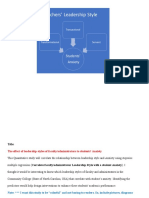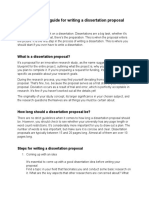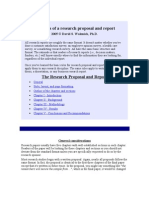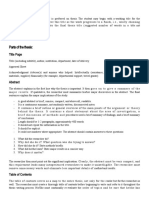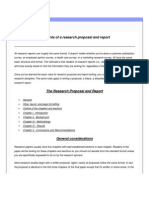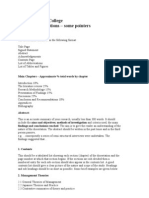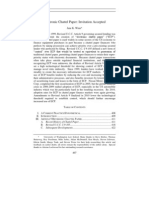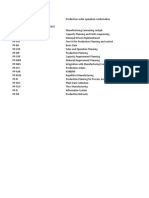How to Write a Dissertation
Dissertations are written for knowledgeable peers in your particular field of study. They
are not written for laymen, or for people in other disciplines. For instance, if you are in the
field of education, you will write your dissertation for knowledgeable peers in education, not
for people from the field of physics. There is a lot of misinformation about this aspect of a
dissertation, but consider the problem of someone from the field of physics trying to write a
dissertation for someone in education, or a layman. Trying to explain common physics
mathematical equations would result in hundreds of pages of explanation. Neither is a
dissertation a textbook. Lengthy explanations that are common knowledge in the field of
study are not appropriate.
The most important first step in writing a dissertation is to identify a gap in the knowledge.
This begins when you identify a problem with the human condition. As an example, the
problem you have identified is that higher than normal attrition of teachers is happening in a
school district, which is causing all the problems associated with high turnover. Your next
step is to search the empirical (research) literature to see if anybody else has investigated the
high turnover in that school district, and if you fail to find any published piece of scholarly
literature, you have a legitimate ‘gap in the knowledge.’ The gap in the knowledge is the most
critical finding you will have because it drives every element of your dissertation. If you do
not identify a legitimate gap in the knowledge, you have no foundation for your study.
Abstract
The abstract is usually found in the preliminary pages and may include only two paragraphs if
it accompanies the proposal to do the study, or it is written after the study is complete. An
1
�abstract is normally four small paragraphs or one unbroken paragraph and may not exceed
250-350 words according to university standards. The length of the abstract is driven by the
electronic cataloging of dissertation abstracts. It is comprised of (a) one paragraph that
identifies the problem and related purpose of the study, (b) one paragraph about the methods,
(c) one paragraph about the findings, and (d) one paragraph about the conclusions and
recommendations.
Chapter I – Introduction
Chapter I, with a thorough review of the literature, is normally the “prospectus” that a
committee approves before the “proposal” to begin research is approved. The proposal, which
follows the prospectus, is the first three chapters of the dissertation. After the prospectus is
approved, some of the review of literature may be moved to Chapter II, which then becomes
part of the proposal. Once the proposal is approved, some of the methodology in Chapter I
may be moved into the Chapter III.
Chapter I is the engine that drives the rest of the document, and it must be a complete
empirical argument. It is narrowly focused on the gap in the knowledge. Dissertations are
somewhat repetitive. Once you establish a word or words to identify something, stick with it
throughout. Dissertations are not an exercise in creative writing, so do not try to find new
words for the same thing every time you mention it. Use plenty of transitional sentences from
one section to another. Following is an outline of the content of a typical Chapter 1.
Introductory paragraph. State the general field of interest, and end with a sentence that states
the general subject of the research project. Do not keep the reader waiting to find out what
you are going to do. Your first subheading follows.
2
�Background of the Problem. A brief 3-4 page summary of the major findings in the field of
interest narrowly focused on the gap in the knowledge. The task is to prove that the gap in the
knowledge has not been studied. Citations should be within the 5 years previous to your own
study. These paragraphs point out unresolved issues, conflicting findings, social concerns, or
educational or national/international issues, and lead to the next section, the statement of the
problem. A good Background of the Study has a minimum of two to three citations to the
literature in every paragraph.
Statement of the Problem. Arising from the Background of the Study is this statement of the
problems that are occurring and a specific statement of the exact gap in the knowledge you
will study. The gap in knowledge is the nerve center for your study.
Purpose of the Study. One to two paragraphs that state your intention to address the gap in the
knowledge.
Research Question(s). These are your basis for action and arise from your attack on the gap in
the knowledge. When your research is finished, your contribution to the knowledge will be
the answers to these questions.
Hypotheses. These are found primarily in quantitative studies. Each research question will
have both a primary hypothesis and a null hypothesis.
The Background of the Problem the Statement of the Problem, the Purpose of the Study, and
the Research Questions area are all narrowly focused on the gap in the knowledge. Use the
same language in the same way throughout.
Significance of the Study. A statement of why it is important to study the problem, and how
the solution will improve the human condition.
3
�Research Design. This is sometimes entitled Nature of the Study, and some committees want
it only in Chapter 3. This is a summary of the methodology that contains a brief description of
three things: (a) the participants or subjects of the research, (b) the instrumentation used to
collect data, and (c) the procedure that will be followed.
Of note is Institutional Review Board approval for the use of human subjects, if you have
them, which is a Federal law. Also, if you are investigating minors, you must have parental
approval. These two subjects are in Chapter 3 of some dissertations.
Assumptions. An assumption is a self-evident truth. For instance, it is assumed that
participants in either a quantitative or qualitative study will answer questions honestly and to
the best of their abilities.
Limitations, and/or Delimitations. Limitations are things over which the researcher has no
control, such as bias, and delimitations are things over which the researcher has control, such
as the place of the study.
Definition of Terms. Define terms that may have more than one meaning among
knowledgeable peers.
Remember that an individual advisor or department may reorganize, add or delete from the
above list, or require you to put a subject elsewhere, but the basic foundation of the study will
remain the same.

